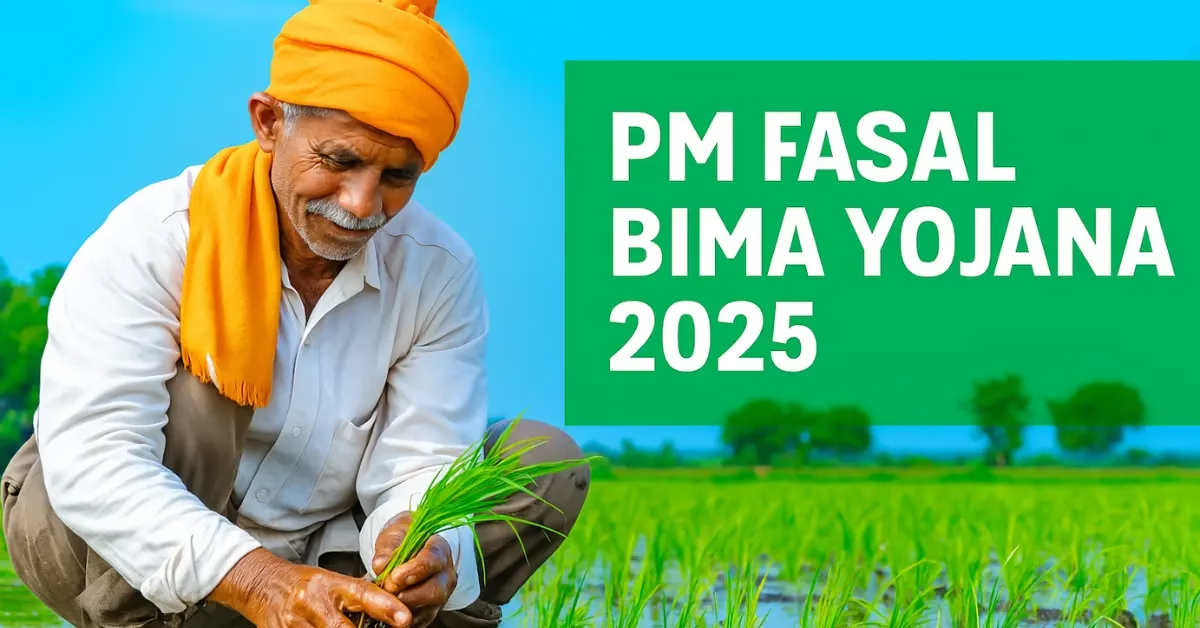The Pradhan Mantri Fasal Bima Yojana (PMFBY) was introduced on 18 February 2016, aiming to replace the previous crop insurance schemes, NAIS and MNAIS. These schemes provide farmers with financial support to offset crop losses resulting from various factors, including natural disasters, pests, diseases, and post-harvest risks, aiming to stabilize their incomes and maintain a steady flow of farming credit.
PMFBY covers food grains, millets, pulses, and oilseeds, and annual commercial/horticulture crops in geographical areas. The schemes followed mandatory coverage for loanee farmers, but since 2020, it has been fully voluntary for all farmers.
Premiums & Cost-Sharing
- Farmers pay capped premiums:
- Kharif crops: 2%
- Rabi crops: 1.5%
- Commercial/horticultural crops: 5%
Remaining subsidy is shared between Central and State governments (50:50; 90:10 in North‑Eastern States from 2020).
- Kharif crops: 2%
Participation & Scale
- In the year 2023–24, over 41 million farmers enrolled, covering around 61.7 million hectares, making it the largest crop insurance scheme globally in enrollment and area covered.
- In 2024–25, enrollment reached its highest-ever level with 4.19 crore (41 million) farmers, though marginal (17.6%) and tenant (6.5%) farmers remained under‑represented compared to loanee farmers (48%).
Challenges & Defaults
- State Defaults
From FY2021 to FY2025, states defaulted on over ₹6,450 crore towards claim settlements, delaying payouts and affecting trust. Key defaulters: Andhra Pradesh (₹2,565 cr), Rajasthan (₹1,525 cr), Madhya Pradesh (₹1,468 cr), Tamil Nadu (₹124 cr), Uttar Pradesh (~₹121 cr). - Delays & Rejections
Farmers often experience delays in payouts. Half of Maharashtra’s insured farmers received no compensation between 2016–17 and 2023–24 despite paying larger premiums, raising concerns of insurer bias due to area‑based assessment and claim rejection policies. - Assessment Bottlenecks
Manual crop-cutting experiments and outdated methods lead to inefficiencies and inconsistencies. Coverage remains low for tenants and marginal farmers.
Reforms & Technological Improvements
- Digital Infrastructure
Launch of the National Crop Insurance Portal (NCIP) for unified enrollment, claim tracking, and transfers; DigiClaim integration since Kharif 2022; Crop‑Cutting Experiments‑Agri App; YES‑TECH (yield‑estimation tech) mandatory for paddy, wheat, and soybean from Kharif 2024; expanded WINDS weather data network at Gram‑Panchayat level. - Penalty & Escrow Mechanisms
Insurance companies face automatic 12% penalties for delayed payouts from Kharif 2024 onwards. From Kharif 2025–26, states must deposit their share of the premium subsidy into escrow accounts to ensure prompt fund availability. - Subsidy Delinking
Centre’s share of claim payout is decoupled from state contributions, ensuring that farmers receive at least the central portion of the claim even if states default. - Mandatory tech in yield estimation
Minimum 50% weighting to technology-based YES‑TECH, reducing reliance on manual crop-cutting survey methods from 2025–26 onwards.
Damage Compensation & How To Apply (2025 Updates)
- Deadline
For Kharif 2025, the enrollment deadline is 31 July—farmers must register by this date to avail coverage. - Registration Process
Farmers register via pmfby.gov.in, providing Aadhaar, bank details, crop type, land area, and ownership proofs (e.g., Khatauni, bank passbook). They may also enroll through CSCs or local agricultural offices. - Claim Filing
- Report losses within 48–72 hours using the Crop Insurance App or toll‑free helpline.
- Provide loss details (crop, location, date, Aadhaar).
- Local officials or drones conduct a field inspection; the district nodal officer uploads the damage assessment report to the NCIP for settlement.
- Report losses within 48–72 hours using the Crop Insurance App or toll‑free helpline.
At a Glance: PMFBY Summary Table
| Feature | Details |
| Launch | Feb 2016 (central scheme replacing NAIS/MNAIS) |
| Eligibility | All farmers (loanee, marginal, tenant) growing notified crops |
| Premium (farmer share) | 2% (Kharif), 1.5% (Rabi), 5% (commercial/horticultural) |
| Subsidy sharing | 50:50 Central‑State (90:10 in NE states) |
| Coverage risks | Pre-sowing, mid-season calamity, standing crop, localized, post-harvest |
| Technology tools | NCIP, DigiClaim, Agri‑App, YES‑TECH, WINDS |
| Defaults (FY21‑25) | ₹6,450+ crore by states—delayed payouts |
| Recent reforms | Escrow funds, penalty on delays, delinking subsidy |
| Enrollment 2024‑25 | 41 million farmers, 61.7 million ha |
PMFBY has grown into the world’s largest crop insurance scheme in terms of enrollment and scale. Despite high uptake and payouts amounting to nearly five times the farmers’ premium payments (~₹1.78 lakh crore), the scheme faces challenges: state defaults, delayed/partial settlements, and under-representation of tenant/marginal farmers.
Reforms introduced from 2024–25—including escrow mandate, technology-based assessments, DigiClaim module, and penalties—aim to fix these issues and improve transparency, timeliness, and trust in the system. Farmers are urged to enroll before deadlines and use digital tools to claim benefits promptly.
Hi, this is Admin from Indnexa. We publish content here that is authentic and has value for our readers. We do not mislead our readers by publishing fake news . We cover news related to Entertainment, Sports, Investments, Health, and so on. Providing the best news for our readers is our main motto. With a keen eye for detail and a drive to inform and inspire, we try to transform complex ideas into accessible content for curious minds.

